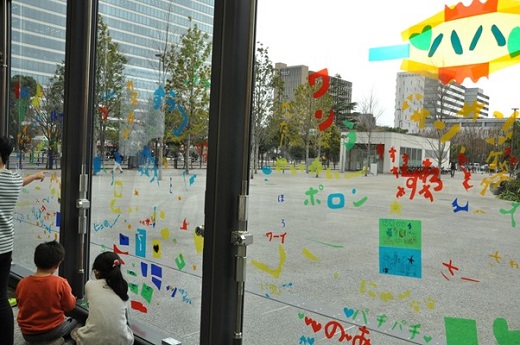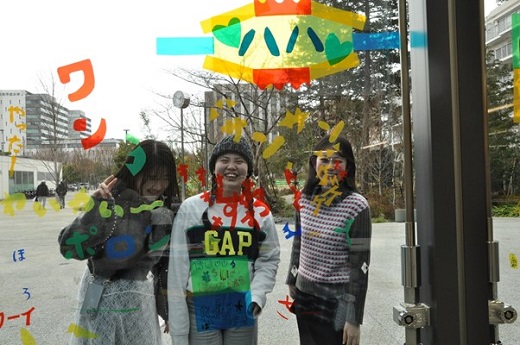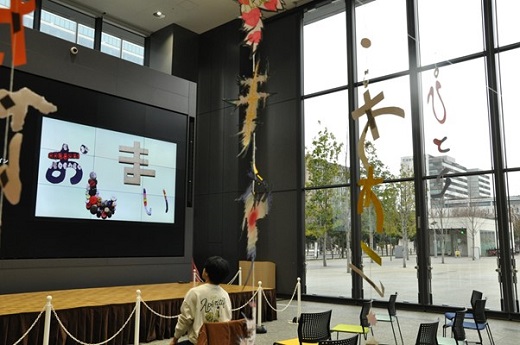[School of Global Japanese Studies]Connecting Nakano City and people with sound - New scenery found at Kishi Seminar Arts-Based Research (ABR)
Mar. 11, 2025



The Kishi Seminar is engaged in Arts-Based Research (ABR). This time, in collaboration with various individuals and organizations such as Nitobe Bunka Gakuen VIVISTOP, JTB Communication Design, musician Akiko C-NA, and Visual Exploration Learning Combibi, we conducted “Ugokuoto: Let's collect sounds of Nakano city and make a video” to explore (rediscover) the city of Nakano through sounds.
The project was started in November 2024, and after about two months of preparation and production, it was exhibited at “Nakanova,” an event space on the first floor of the Nakano Ward Office, on January 19, 2025, as “Nakano Gion Matsuri.” (Gion means onomatopoeia in Japanese)
The “Nakano Gion Matsuri” consisted of two activities, walking around the city and creating Gion, and art workshops.
The project “Ugokuooto”: Let's make a video by collecting sounds from the Nakano city” was implemented over about two months starting in November 2024. Elementary school students to adults walked around the city, found Gion, designed and moved them, put sounds on them, and animated them. The video edited by professionals in music and video production was on the screen at “Nakanova.”
Below are reports from four students who participated in this practice.
Report 1: SUZUKI Ayami (3rd year student, Kishi Seminar)
We walked through Nakano city and thought of Gion to match the appearance of a place that somehow caught our attention and expressed it. The most interesting thing about this project was that each person's places of interest and the Gion they associate with them are completely different. Therefore, by sharing the completed works, I learned what the participants were thinking and their intentions, and I felt that I deepened my understanding for others.
Report 2: TSUCHIYA Shieru (3rd year student, Kishi Seminar)
I remember that I was surprised to find many unexpected things even on roads that I am familiar with. I also noticed that I rarely take the time to walk around and look at my surroundings. When I designed what kind of Gion we could hear from the photos and shared them with the participants, I realized that there were many Gion that I had not found or thought of, even though we had followed a similar path. The diversity of the workshop, in which both children and adults participated, was unique to the workshop. I also felt very comfortable in a space where everyone was absorbed in thinking about what they envisioned and how they could express it, rather than in an atmosphere where everyone tried to do their best and create something amazing.
Report 3) HANASAKI Hinata (3rd year student, Kishi Seminar)
Each participant was so absorbed in crafting that they did not directly interact with each other. However, more and more windows were decorated with Gion and pictures, and it was as if they were interacting indirectly through the windows, making it a very warm place. One of the participants was making a Gion called “haha.” When we asked them about it, they said it represented the warmth and fun of the event place.
Report 4) OKABE Misuzu (3rd year student, Kishi Seminar)
On the day of the Gion Matsuri, many people came to the event and I enjoyed the process of turning Gion into letters together with everyone. It was interesting to learn about various their own Gion by layering colored paper, or by drawing pictures on colored paper, expressing their Gion in ways they had never imagined. I experienced the fun of creating an event together with the participants. Also, seeing how other people added to the already existing Gion, I felt an indirect exchange through art.
Some participants commented that “the way I see the city of Nakano has been changed” and “I feel as if I can hear joyful sounds when I walk around the city,” and I believe that the event led to a rediscovery of the city of Nakano.
This practice is also scheduled to be implemented on the 1st floor of Meiji University's Nakano Campus in April 2025. More details about this will be posted on the website.
≪Japanese version≫
The project was started in November 2024, and after about two months of preparation and production, it was exhibited at “Nakanova,” an event space on the first floor of the Nakano Ward Office, on January 19, 2025, as “Nakano Gion Matsuri.” (Gion means onomatopoeia in Japanese)
The “Nakano Gion Matsuri” consisted of two activities, walking around the city and creating Gion, and art workshops.
The project “Ugokuooto”: Let's make a video by collecting sounds from the Nakano city” was implemented over about two months starting in November 2024. Elementary school students to adults walked around the city, found Gion, designed and moved them, put sounds on them, and animated them. The video edited by professionals in music and video production was on the screen at “Nakanova.”
Below are reports from four students who participated in this practice.
Report 1: SUZUKI Ayami (3rd year student, Kishi Seminar)
We walked through Nakano city and thought of Gion to match the appearance of a place that somehow caught our attention and expressed it. The most interesting thing about this project was that each person's places of interest and the Gion they associate with them are completely different. Therefore, by sharing the completed works, I learned what the participants were thinking and their intentions, and I felt that I deepened my understanding for others.
Report 2: TSUCHIYA Shieru (3rd year student, Kishi Seminar)
I remember that I was surprised to find many unexpected things even on roads that I am familiar with. I also noticed that I rarely take the time to walk around and look at my surroundings. When I designed what kind of Gion we could hear from the photos and shared them with the participants, I realized that there were many Gion that I had not found or thought of, even though we had followed a similar path. The diversity of the workshop, in which both children and adults participated, was unique to the workshop. I also felt very comfortable in a space where everyone was absorbed in thinking about what they envisioned and how they could express it, rather than in an atmosphere where everyone tried to do their best and create something amazing.
Report 3) HANASAKI Hinata (3rd year student, Kishi Seminar)
Each participant was so absorbed in crafting that they did not directly interact with each other. However, more and more windows were decorated with Gion and pictures, and it was as if they were interacting indirectly through the windows, making it a very warm place. One of the participants was making a Gion called “haha.” When we asked them about it, they said it represented the warmth and fun of the event place.
Report 4) OKABE Misuzu (3rd year student, Kishi Seminar)
On the day of the Gion Matsuri, many people came to the event and I enjoyed the process of turning Gion into letters together with everyone. It was interesting to learn about various their own Gion by layering colored paper, or by drawing pictures on colored paper, expressing their Gion in ways they had never imagined. I experienced the fun of creating an event together with the participants. Also, seeing how other people added to the already existing Gion, I felt an indirect exchange through art.
Some participants commented that “the way I see the city of Nakano has been changed” and “I feel as if I can hear joyful sounds when I walk around the city,” and I believe that the event led to a rediscovery of the city of Nakano.
This practice is also scheduled to be implemented on the 1st floor of Meiji University's Nakano Campus in April 2025. More details about this will be posted on the website.
≪Japanese version≫


